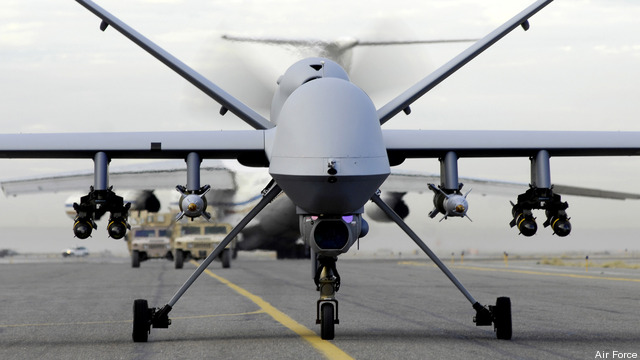Drone Strikes: ‘Least Horrible’ Choice In Pakistan, Yemen
Posted on

WASHINGTON: In lawless, inaccessible regions of the world, drone strikes are America’s least-worst option for pursuing terrorists, a panel of experts agreed today — and many of the civilians whose deaths are blamed on US drones were actually killed by local factions on the ground or never existed at all.
“They are actually our least horrible option,” said Prof. Christine Fair, a South Asia expert at Georgetown University who has made many trips to Pakistan, including to the badlands known formally as the Federally Administered Tribal Areas (FATA). “I am… within the strict case of FATA, a drone proponent,” she said, speaking Monday afternoon at the American Security Project in Washington, DC. And while most Pakistanis deplore the drones when polled about them, Fair added that FATA residents she spoke to who have first-hand knowledge of specific strikes and who really died in them are, “very positive…. They know who’s being killed.”
So while the risk of backlash against Unmanned Aerial Vehicle (UAV) attacks is real, the alternatives are worse because they would cause even more unintended casualties — American, allied, and civilian — while doing less damage to the terrorists. It would be ideal to capture terrorists, bring them to justice, and interrogate them rather than kill them, Fair said, but in the Pakistani tribal lands, “there are no police, there are no law enforcement agencies. When the Pakistani military goes in after insurgents, she said, “they’re very imprecise and kill loads of people,” sending thousands of civilians fleeing from their homes.
An American ground attack would be even more costly in human, military, and political terms, added CNA research analyst William McCants, editor of Jihadica.com. After 9/11, McCants noted, America’s initial response to countries that it thought harbored terrorists was to invade, not just bomb specific targets: The shift to drones, he argued, is actually a de-escalation, “a reaction to this overreaction.” The risk of anti-US backlash remains, McCants said, but it is driven less by US drone strikes specifically than by US support in general for oppressive regimes, like that in Yemen, as they crack down “indiscriminately” against both terrorists and political critics.
In Afghanistan and Pakistan, even al-Qaeda and Taliban themselves make relatively little use of drone attacks to motivate supporters and recruits, added Aaron Zelin, a fellow at the Washington Institute for Near East Policy: “They more or less have been mum about this issue in their propaganda,” he said. Al-Qaeda’s Yemeni branch has put drone-related video online, but that has focused instead on the grisly executions of alleged US informants who provided targeting data, which is a backhanded compliment to the often paralyzing “paranoia” the drone strikes have created among their targets.
While it is difficult to measure the damage done to al-Qaeda as an organization, Zelin went on, one telling sign is that al-Qaeda used to hold month-long training courses for new bomb-makers. Not so much these days. In Yemen for example, recruits now come together briefly to practice with various weapons and then “melt away into the desert.” As a result, al-Qaeda explosives have often failed to go off in recent plots.
But what about the civilian deaths that are sometimes the price of such successes? “We’re looking at really lousy data,” said Fair. In FATA, “there are no birth certificates and there are no death certificates,” she said, and many news reports on drone strike deaths don’t even “try to confirm there was in fact a burial.” Drone strikes tend to take place in the same areas where insurgents and the Pakistani authorities are already clashing, she said, and, on closer examination, some of the injuries attributed to US drones are more likely to come from terrorist bombs — “the Taliban don’t always claim the bad stuff they do” — or from errant ordnance from Pakistani military operations. Some of the alleged victims don’t seem to have ever existed.
Civilian casualties from strikes against terrorists tied to the Pakistani military are often inflated in the Pakistani press, she said, while those from strikes against enemies of Islamabad are downplayed. Between unreliable Pakistani sources and a close-mouthed US government, Fair said, the picture is painfully foggy.
“The lack of empirical data… should be ensuring a certain amount of humility about our ability to draw conclusions,” summed up Joshua Foust, the American Security Project fellow who hosted Monday’s discussion. Having just published his own study on the subject, he said, drones’ value for specific tactical missions is clear, but their long-term strategic effect is not. His greatest worry is that “in a lot of ways drones have taken the place of US strategic decisionmaking,” Foust said. “People think there’s a problem, it’s a difficult place to get to, [they say] ‘let’s send in drones, that solves the problem.'” Drones are a tool of strategy, and a powerful one — but not a strategy in themselves.
Subscribe to our newsletter
Promotions, new products and sales. Directly to your inbox.
